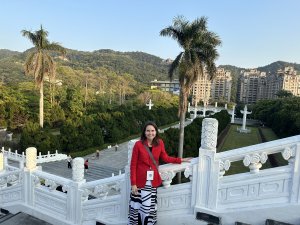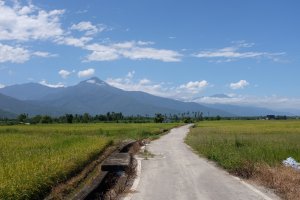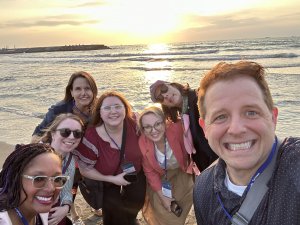On Orchid Island, the Taotao is a ubiquitous symbol. It can be found inside churches, outside of 7-11, adorning many a tourist trinket, and most importantly, on every Tao boat. Known as (人型 renxing the person symbol), the Taotao is often depicted as a small person with swirled arms and “curly Qs” coming out of its head. Whimsical in appearance, but steeped in meaning, the Taotao represents a person’s relationship with his or her physical environment. For Tao people, this environment includes dense mountainous jungle, rocky beaches, and the crystal blue expanse of the Pacific Ocean.
Living on a small island over 40 miles from Taiwan and the Philippines, the people of this island have historically had a comprehensive knowledge of their environment. In fact, the Tao people had such a depth of understanding that Orchid Island was self-sustaining until the Japanese occupation of Taiwan at the turn of the 20th century. While the Tao are the only of the 16 officially recognized indigenous tribes of Taiwan that have taboos with otherworldly ramifications, many of these taboos actually contribute to the ecological sustainability of the island. For example, the taboo that forbids island residents from fishing for or eating any other fish besides the flying fish and the mahi-mahi that pursue them during the “Flying Fish Season” (a period that extends roughly from March to June) is extremely beneficial for the coral reef and coastal waters surrounding the island. By following this custom, Tao men are only catching the fish that actively pass Orchid Island in vast numbers leaving other species, such as tuna and octopus, time to replenish their stocks. Tao taboo further divides all species into different categories: fish for the elderly, men’s fish, women’s fish, and fish that anyone can eat (children can generally eat most fish). For example, “Ivay,” a type of lantern fish, is designated as a “women’s fish” and can only be eaten by women because they believe that it is particularly healthy for women to eat, but not as healthy for men or the elderly. It is made into a soup and given to women after they have given birth for its purported restorative properties. Regardless of how accurate these medicinal distinctions between fish prove to be, this taboo serves the important purpose of regulating the amount of fish caught and ensuring that no species are over-fished. In addition, tradition dictates that fish are not to be sold for money, and instead, are to be either used by the family or gifted to friends.
It is clear that the Taotao, a small alien-like figure, something of a wind sprite or man sprouting from a plant, represents a commendable respect for the environment. Yet, if you have the pleasure of staying on Orchid Island long enough, you will almost certainly pick up on an important subtlety: each Taotao is slightly different. Each Taotao design is owned by a fishing group, a group of men–often related–who fish together, either in the same boat such as the big 10 person boat, or with coordinated efforts. The Tao people are what anthropologists classify as a “big-man group” or “big-man society.” In explaining this term, one of my anthropology professors at National Taitung University, jokingly described a scene in which Indiana Jones, upon stepping onto the beach of a remote South Pacific Island, declares to the native people, “Take me to your chief.” However, many Pacific Island societies are not socially organized into chiefdoms, but are rather organized as “big-man societies,” around individuals recognized and respected by the group for their wisdom, persuasiveness, or other leadership skills–in other words, a “big man.” For Orchid Island, this translates into fishing groups. Each village has family clans, and each clan has its own fishing group, led by the man in the group who is respected for his wisdom and leadership, the person naturally and almost automatically recognized as the captain during fishing. From an American perspective, it is easy to think of the big man as a grassroots community leader. Each Taotao is different to denote which clan the boat belongs to. A similar symbol, also found on the boat, but much more simple than the Taotao (for example a w-like wave symbol) is carved onto that clan’s trees to tell other clans that they want to use this particular tree as part of a boat that they are building. As one of my informants said, “There is a popular saying in Chinese, ‘the earlier people plant trees, the later people enjoy the shade.’ In Tao culture, this could be rephrased to read ‘the earlier people plant the trees, the later people build the boats.’” In other words, all of the clans’ trees do not grow by accident or through divine providence. The majority were intentionally planted by the clan’s ancestors because without the proper timber, they would not be able to build a boat; without the boat, they would not be able to fish; and without the ability to fish, they would not be able to survive. As many Tao men attested to me both in language and action, “afforestation is an important part of our culture.”
Therefore, the Taotao represents a respect for nature and a passion based on necessity for ecological sustainability. It denotes the Orchid Islander who hand-carved the Taotao as well as the fishing group associated with it. Not only did I learn what the Taotao means to the Tao people, but I also discovered what it means to me. As a Fulbright Fellow, I look at the individuality of each Taotao and think about how governments should tailor policy to the local environment and the even more localized ecosystem rather than enforcing a blanket environment policy, drawing on a depth of knowledge already possessed by indigenous communities that have been living in that specific area for thousands of years. I look at how indigenous boat builders created a symbol of a person living as a physical part of the environment and ask how can we come up with equally meaningful designs in buildings and civil affairs? Most importantly, I look at how easily I could find common ground and passion among new friends in a culture that is completely different than mine over boat-building, fishing, and diving for sea urchins. I found that in a world where political views and social values are often conflicting, environmental policy initiatives can be a “jumping off point” of cooperation between countries that may not always see eye-to-eye. The experience brought to life for me the Fulbright motto, “a world with a little more knowledge and a little less conflict.” When I see the Taotao, I see that opportunity.





